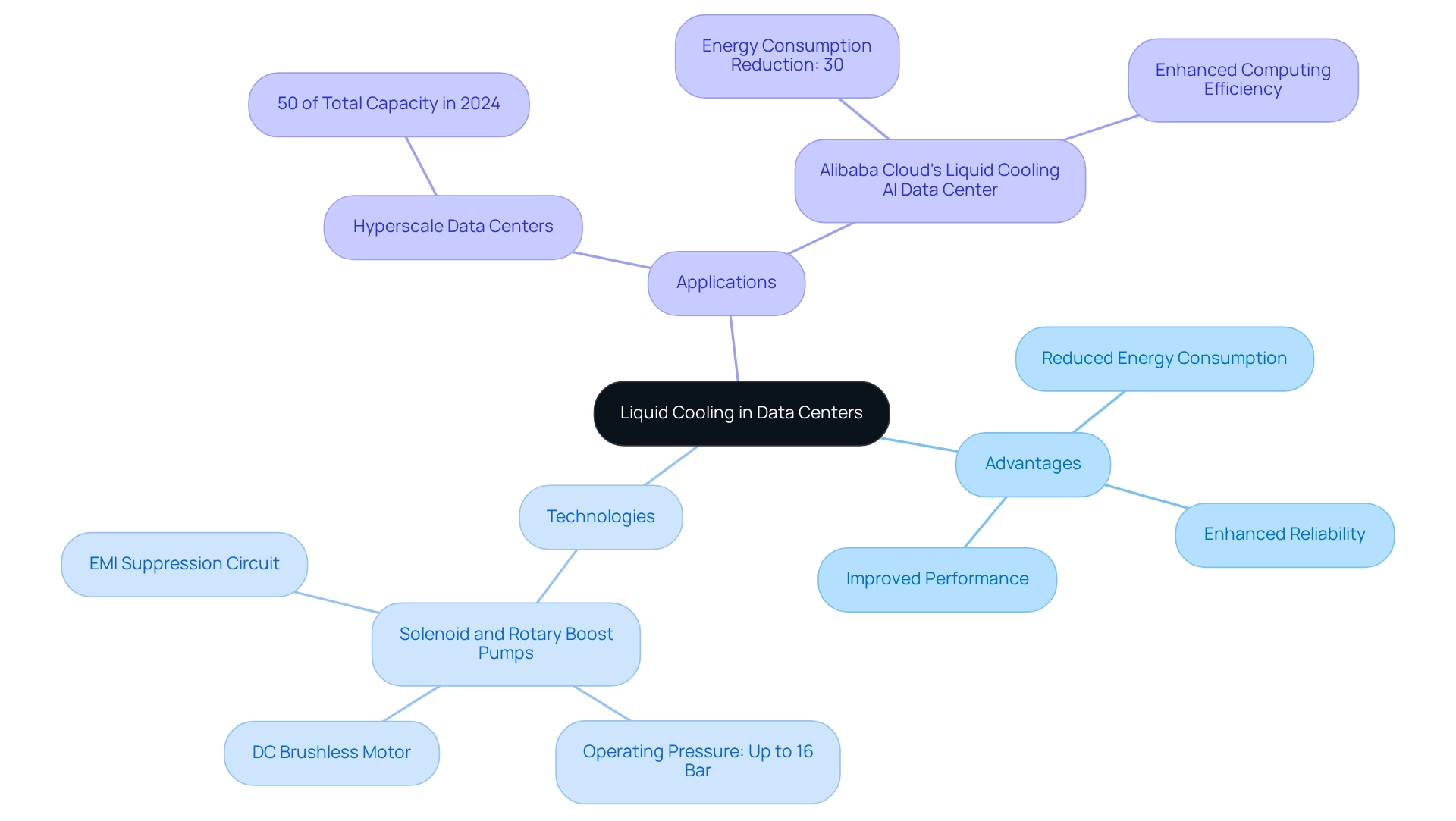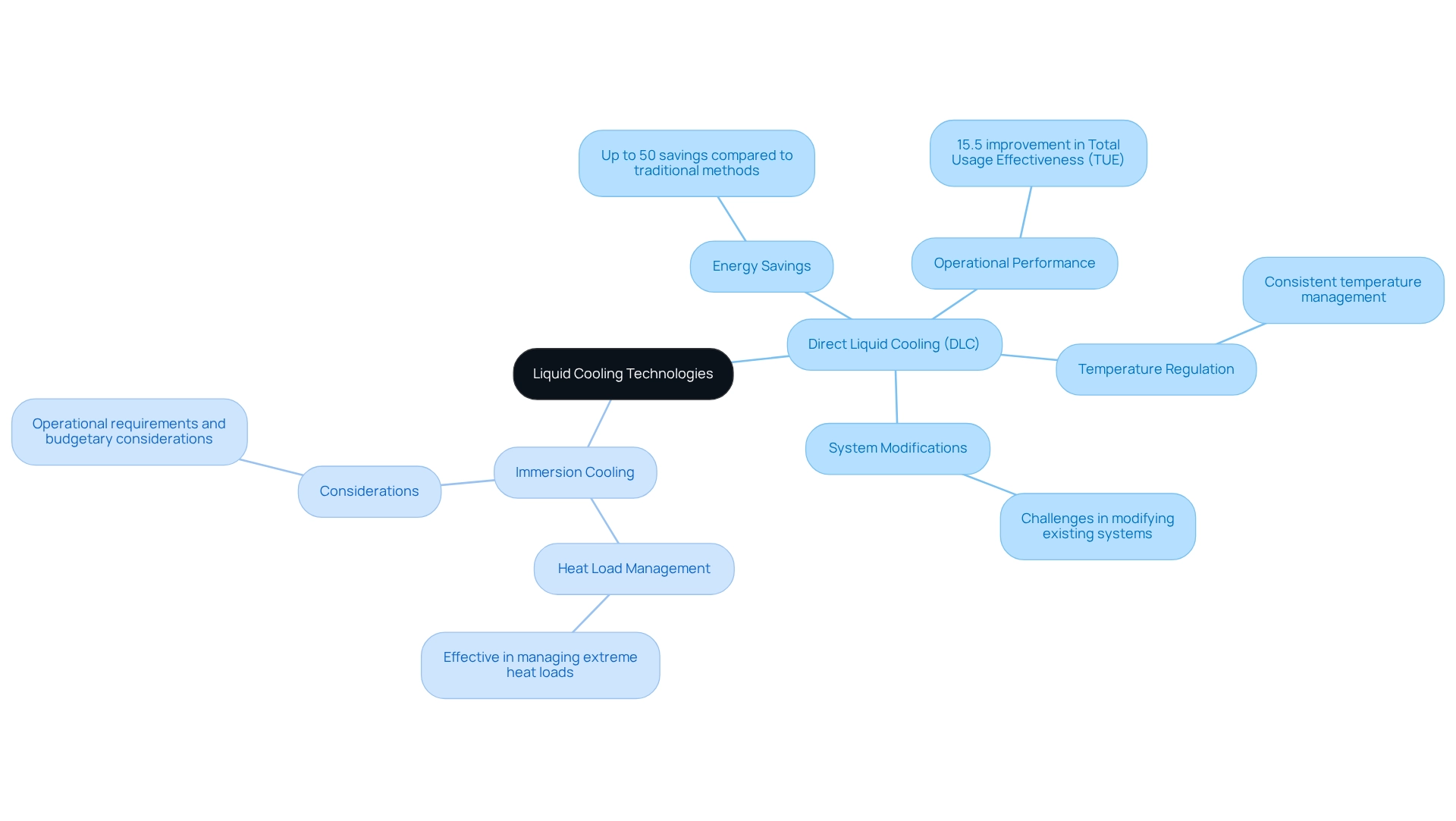Overview
This article delves into the pivotal technologies and implementation strategies surrounding master liquid cooling in data centers, underscoring its advantages over conventional air cooling methods. It asserts that liquid cooling significantly enhances thermal management through its superior heat transfer capabilities. This advancement leads to reduced energy consumption, improved reliability, and enhanced performance in high-density environments—elements that are increasingly vital as data centers adapt to meet the demands of modern computing.
Introduction
In the ever-evolving landscape of data centers, the quest for efficient thermal management has catalyzed the emergence of liquid cooling technologies. Unlike traditional air cooling systems, liquid cooling presents a compelling solution for managing the significant heat produced by high-density computing environments. By employing liquids with exceptional thermal conductivity, these systems not only enhance energy efficiency but also bolster the reliability and performance of critical IT infrastructure.
As organizations endeavor to meet the escalating demands of modern data processing, grasping the intricacies of liquid cooling—from its fundamental principles to the practicalities of implementation—becomes imperative for optimizing operational efficiency and promoting sustainability in data center operations.
Explore the Fundamentals of Liquid Cooling in Data Centers
Liquid cooling data centers employ fluid-based temperature regulation, a sophisticated technique that harnesses fluids to absorb and dissipate heat from data center components, significantly enhancing thermal management compared to traditional air-based methods. The primary advantage of liquid cooling data centers is their superior thermal conductivity; liquids can transport heat away from components more effectively than air, a critical factor in high-density environments where heat generation is substantial.
Gagner-Toomey Associates provides designed for precision applications, capable of operating up to 16 Bar. These pumps feature a DC brushless motor and an EMI suppression circuit, ensuring low noise operation and compliance with industry standards such as NSF and WSAS. For additional information regarding these pumps or to locate a distributor, please visit our product website.
The benefits of fluid temperature regulation are increasingly recognized within the industry. Recent advancements in fluid refrigeration technology have demonstrated substantial energy savings; for instance, liquid cooling data centers are progressively being adopted by hyperscale information centers to meet the demands of modern information processing. Industry specialists advocate for the implementation of liquid cooling data centers, highlighting their advantages over air-based methods, which include:
- Reduced energy consumption
- Enhanced reliability
- Improved performance in high-density settings
As information centers evolve, understanding these fundamentals will empower operators to effectively utilize technologies in liquid cooling data centers, ensuring optimal thermal control and operational efficiency.

Examine Liquid Cooling Technologies: Direct Liquid Cooling vs. Immersion Cooling
Liquid refrigeration technologies are primarily categorized into two types: (DLC) and Immersion Cooling, each offering unique advantages for enhancing center efficiency.
- Direct Liquid Cooling (DLC): This method involves delivering coolant directly to heat-generating components, such as CPUs and GPUs, via cold plates. This targeted approach not only facilitates efficient heat transfer but also renders DLC particularly effective in high-performance computing environments. Notably, DLC systems can achieve energy savings of up to 50% compared to traditional methods, significantly enhancing overall energy efficiency. Recent studies reveal that the Total Usage Effectiveness (TUE) improved by 15.5% following the implementation of DLC solutions, underscoring their substantial impact on operational performance. Consequently, liquid cooling data centers aiming for a robust, scalable, and cost-effective thermal management solution should prioritize direct liquid refrigeration as their optimal choice. This technique provides consistent temperature regulation and excels in managing extreme heat loads, thereby minimizing the need for complex temperature control systems. However, it often necessitates considerable modifications to existing systems, which may present challenges for certain organizations.
Both DLC and immersion temperature control technologies present compelling benefits. When assessing their efficiencies, DLC typically offers superior energy savings and operational performance enhancements, while immersion techniques are adept at managing extreme heat loads. The decision to adopt one technology over the other should be informed by specific operational requirements, existing infrastructure, and budgetary considerations. As the demand for high-density computing continues to rise, understanding these technologies becomes imperative for optimizing center performance.

Implement Liquid Cooling: Design Considerations and Best Practices
Incorporating liquid cooling data centers necessitates a thorough evaluation of multiple essential design elements to guarantee optimal efficiency and reliability.
- Space and Layout: Assess the available area for fluid temperature management systems, ensuring ample room for pumps, heat exchangers, and piping while preserving unobstructed airflow. Studies indicate that raising secondary inlet temperatures to 45°C (113°F) can significantly aid in efficiency and waste heat reuse, making effective space management crucial.
- Infrastructure Compatibility: Evaluate current setups for compatibility with liquid temperature control technologies. Aged facilities might need updating to support new technologies, which is an essential step in the transition process to guarantee smooth integration and functionality.
- Coolant Selection: Selecting the right coolant is vital. Take into account thermal characteristics, ecological effects, and compatibility with the materials utilized in the refrigeration setup to guarantee efficient heat transfer and durability. This choice directly influences the efficiency of the cooling process.
- Maintenance and Monitoring: Create a comprehensive maintenance plan that encompasses regular checks of pumps, coolant levels, and leak detection mechanisms. Implementing monitoring solutions can help track system performance and identify potential issues before they escalate, thereby enhancing reliability.
- Safety Protocols: Establish comprehensive safety protocols for managing coolant spills and ensure that all components are designed to minimize risks associated with liquid temperature regulation. This proactive strategy is crucial for ensuring a secure operational setting and safeguarding staff.
The significance of is highlighted by figures such as the average water usage of Google server facilities, which was around 450,000 gallons daily in 2021. This emphasizes the necessity for innovative temperature control technologies that decrease water consumption while preserving performance. Furthermore, the gradual incorporation of technologies for liquid cooling data centers in Latin America signifies an increasing trend propelled by requirements from information centers backing cloud services and telecommunications.
By following these recommended practices, information centers can effectively adopt fluid temperature regulation solutions, improving overall operational efficiency and dependability. For example, the implementation of the Liebert® XDM Split Indoor Chiller has shown efficient incorporation of fluid temperature control in air-cooled settings, offering an economical solution that aids the shift to fluid temperature management technologies.
Evaluate the Benefits and Challenges of Liquid Cooling Solutions
Liquid cooling solutions present a range of advantages alongside certain challenges that data center operators must navigate:
Benefits:
- Energy Efficiency: Liquid cooling systems can lead to substantial reductions in energy consumption, translating to lower operational costs. Studies indicate that subcooled boiling techniques enable more efficient heat removal compared to traditional single-phase liquid cooling, with efficiency improvements of up to 30%. This further enhances energy savings and supports sustainability goals.
- Higher Heat Density: These systems are capable of managing higher heat loads, making them particularly suitable for contemporary server configurations that utilize dense server arrangements. This capability is crucial as data centers evolve to support increasingly powerful computing demands.
- Enhanced Reliability: By maintaining optimal operating temperatures, fluid-based thermal management solutions can significantly improve the longevity and performance of IT equipment, reducing the risk of overheating and related failures. For example, AmpCool® from Engineered Fluids is specifically designed for refrigerating batteries, electric motors, and electronic motor controllers, providing improved heat dissipation, insulation, and lubrication.
Challenges:
- Initial Costs: The upfront investment required for liquid cooling systems often exceeds that of conventional air cooling solutions, which can deter some operators from making the switch. This financial consideration is critical, especially for facilities with tight budgets.
- Complexity of Implementation: Integrating liquid temperature regulation into existing data center infrastructures can be complex. It necessitates meticulous planning and may require substantial enhancements to current infrastructures, posing logistical challenges. For instance, the research named “Microchannel Heat Sink Design and Research Gaps” emphasizes the necessity for additional experimental investigation on microchannel internal flows, which are crucial for enhancing the design and efficiency of thermal management solutions.
- Maintenance Requirements: Regular upkeep is crucial for fluid refrigeration setups to guarantee optimal performance and to avert possible leaks. This ongoing requirement can add to operational complexities and costs. Real-world instances demonstrate that information centers frequently encounter difficulties in sustaining these systems, resulting in heightened downtime and operational inefficiencies.
By carefully weighing these benefits against the challenges, data center operators can make informed decisions regarding the adoption of that align with their operational objectives and sustainability goals.
Conclusion
The exploration of liquid cooling technologies in data centers highlights a transformative approach to thermal management that significantly outperforms traditional air cooling systems. By leveraging the superior thermal conductivity of liquids, these systems deliver enhanced energy efficiency and improved reliability—crucial factors as the demand for high-density computing continues to rise. The distinction between Direct Liquid Cooling and Immersion Cooling illustrates the diverse options available, each tailored to meet specific operational needs while maximizing performance.
Implementing liquid cooling necessitates meticulous planning and consideration of key design factors, including space, infrastructure compatibility, and coolant selection. Adhering to best practices can lead to successful integration and operation, ultimately enhancing the efficiency and longevity of IT equipment. While the initial investment and complexity of these systems present challenges, the long-term benefits—such as substantial energy savings and the capability to manage higher heat loads—render them a compelling choice for modern data centers.
As organizations navigate the evolving landscape of data processing, understanding and adopting liquid cooling technologies is essential. By prioritizing efficient thermal management solutions, data center operators can not only meet the increasing demands of their operations but also contribute to sustainability initiatives. This ensures that their infrastructure remains resilient and future-ready.
Frequently Asked Questions
What is liquid cooling in data centers?
Liquid cooling in data centers is a temperature regulation technique that uses fluids to absorb and dissipate heat from components, providing superior thermal management compared to traditional air-based methods.
What are the advantages of liquid cooling over air-based methods?
The primary advantages of liquid cooling data centers include reduced energy consumption, enhanced reliability, and improved performance in high-density environments where heat generation is substantial.
How does liquid cooling improve thermal conductivity?
Liquids can transport heat away from components more effectively than air, making them more efficient for thermal management in high-density settings.
What products does Gagner-Toomey Associates offer for liquid cooling applications?
Gagner-Toomey Associates provides innovative solenoid and rotary boost pumps designed for precision applications, capable of operating up to 16 Bar, featuring a DC brushless motor and an EMI suppression circuit for low noise operation.
Why are liquid cooling data centers being adopted by hyperscale information centers?
Liquid cooling data centers are being adopted by hyperscale information centers due to advancements in fluid refrigeration technology that demonstrate substantial energy savings and the ability to meet the demands of modern information processing.
How can operators effectively utilize liquid cooling technologies?
Understanding the fundamentals of liquid cooling will empower operators to implement these technologies effectively, ensuring optimal thermal control and operational efficiency in data centers.

